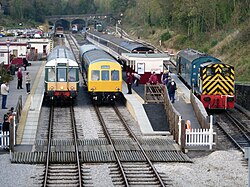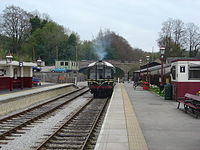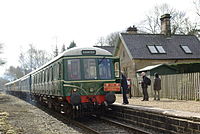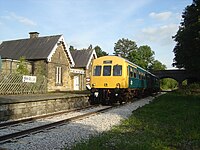Ecclesbourne Valley Railway: Difference between revisions
Created page with "{{Infobox heritage rail |name=Ecclesbourne Valley Railway |county=Derbyshire |picture=Wirksworth Station Overview.jpg |picture caption=Wirksworth Station |os grid ref= |latitu..." |
No edit summary |
||
| Line 8: | Line 8: | ||
|longitude=-1.569 | |longitude=-1.569 | ||
|terminus=[[Ravenstor]]; [[Duffield]] | |terminus=[[Ravenstor]]; [[Duffield]] | ||
|gauge={{ | |gauge={{RailGauge|standard}} | ||
|ownership= | |ownership= | ||
|operator=WyvernRail plc | |operator=WyvernRail plc | ||
Revision as of 20:37, 6 May 2021
| Ecclesbourne Valley Railway | |
|
Derbyshire | |
|---|---|
 Wirksworth Station | |
| Gauge: | standard |
| Location: | 53°4’60"N, 1°34’8"W |
| No. of stations: | 5 (to be 6) |
| Track: | 9 miles |
| Headquarters: | Wirksworth |
| Information | |
| Operated by: | WyvernRail plc |
| Website: | www.e-v-r.com |

The Ecclesbourne Valley Railway is a nine-mile long heritage railway in Derbyshire. The headquarters of the railway centre on Wirksworth station, and services operate in both directions between Wirksworth and Duffield and from Wirksworth to Ravenstor.
From April 2011 onward, passengers have been able now able to board and alight heritage services at Duffield, where in recent years a station platform (3) has been re-constructed. Heritage services are timed to connect with East Midlands Railway Nottingham - Derby - Matlock service at the adjacent Duffield. Network Rail platforms and therefore it is now possible for passengers to travel to and from Wirksworth by train from anywhere on the national network.
The Ecclesbourne Valley Railway runs on what had been a branch line of the British Rail network. It is named after the River Ecclesbourne and the track follows the river from its source to its confluence with the River Derwent by Duffield.
A separate half-mile branch line operates from Platform 3 at Wirksworth Station up a 1 in 27 gradient incline to Ravenstor, (for access to the National Stone Centre and the High Peak Trail).
The line is operated by a large fleet of heritage Diesel Multiple Units, as well as diesel and visiting steam locomotives. Locomotive hauled trains initially only operated on Enthusiast and special event days often alongside the DMU fleet, whereas now locomotive hauled services make up a larger part of the railway's timetable.[1]
History
Origin
The railway was originally the Wirksworth Branch, which was the product of early 19th century railway rivalry. Since 1835 Wirksworth's citizens had been promoting the idea, among others, for a branch line from the North Midland Railway, later the Midland Railway, at Duffield. The Midland was initially unenthusiastic, but then realised that the branch could be extended to Rowsley, albeit with difficulty, avoiding the section from Ambergate, on its Manchester, Buxton, Matlock and Midlands Junction Railway, which was shared with its rival the London and North Western Railway.[2] It is for this reason that all of the bridges along the line, including the one which simply has a head shunt under it (Cemetery Lane) are built to double-tracked grand Midland Railway style.
Construction
The route was eight and a half miles long, and was surveyed in 1862 and received Parliamentary assent the following year. It would follow the valley of the River Ecclesbourne with no major obstacles apart from the final climb into Wirksworth. A cutting was required, and some buildings were demolished, while there was considerable upheaval in Duffield.
The line was opened to Wirksworth on 1 October 1867.
Under the original scheme, the line would have descended from Wirksworth to Cromford using a tunnel 1,503 yards long and a viaduct of 280 yards, and would have proceed parallel to the existing line, but on the west side of the river through Matlock to Rowsley. However, when the lease expired on the original Ambergate line, the LNWR withdrew, and the Midland acquired complete control. Thus the section beyond Wirksworth was never built. The Midland was left with one of its few branch lines, and one which, it felt, was of questionable viability.
Operation
The presence of the line allowed Wirksworth's limestone business to develop, the carriage of which was its mainstay until the middle of the 20th century. There was also farm produce, particularly milk, some 800,000 gallons daily, and a number of textile mills. (The mills of Wirksworth had the dubious distinction of being the main supplier of red tape for the London Government Departments, which was carried down on this line.) The line saw a regular passenger service, with stations at Hazlewood (about half a mile from the village down a steep hill and originally called Windley), Shottle (originally Cowers Lane) and Idridgehay.
Traffic on the line declined up to the War. Passenger trains were temporarily suspended in 1947 and were officially ceased in 1949.
When the so-called Derby Lightweights were produced they were each tested on the line after leaving the workshop.
Although most goods traffic had transferred to the roads, limestone traffic continued, including that formerly hauled by the Cromford and High Peak Railway, when it closed in 1967. Though the amount of traffic justified the installation of some continuous welded rail in the 1980s, production was increasingly of aggregate carried by road. In 1991 the new owner of the quarries no longer needed a rail link.
Preservation
In 1996, WyvernRail were awarded a Light Railway Order for the full length of the whole line.[3] Wirksworth station was reopened in 2002, with the first half-mile of line between Wirksworth and Gorsey Bank reopened for a DMU shuttle passenger service in 2004, followed by a new line to Ravenstor in 2005. On 8 March 2008, the railway began to branch its passenger operations further south, holding a grand opening ceremony for the line between Wirksworth station and Idridgehay station, which was three and a half miles of the line's total length.
In 2005, WyvernRail purchased almost the entire railway.[4] The only portion still leased is an area of the station yard in Wirksworth which has been retained by Network Rail as a Strategic Rail Site and is on a rolling 3-year lease to WyvernRail.[5]
In July 2005 WyvernRail adopted Duffield railway station under a scheme promoted by the Friends of the Derwent Valley Line. They undertook to provide care and maintenance of the station on behalf of Central Trains who operated it at that time.[6]
Signalling and line operation
The railway principally operates on a token system, with the Wirksworth to Duffield section currently holding one token in the form of an 'Annett's key'. The Wirksworth to Ravenstor incline holds a different Annett's key. Due to a ruling gradient on the line, the Wirksworth to Duffield section is protected by a trap-point just north of Wirksworth Station. The Wirksworth- Duffield line can now also be split in two sections with the installation of a passing loop at Shottle. This currently only happens on special events and bank holidays, as it requires two signalmen, one at each end of the loop, to be stationed for the day as there is currently no signal box to control movements in and out of the loop centrally. The former Oddingly crossing box is currently being restored for use as a signal box at Shottle. Two-train operation should be able to happen more regularly once it is finished.
An unusual piece of track work was installed at Wirksworth on platform 3. The track was interlaced (overlapping) either to allow the platform to be used for passenger trains or to allow wagons to collect stone from the adjacent dock. The interlaced section of track was operated by a manual tight point but still came under the control of the Wirksworth-to-Ravenstor train token. This feature has since been removed, however, as it was no longer required.
There were (and currently still are) very few physical signals on the line, apart from indications at cross-overs. One semaphore signal was located almost underneath Cemetery Lane Bridge, but this has recently been relocated to Shottle station as part of the signalling project for the passing loop. Another electronic signal was located at Duffield station to warn that it is the end of the line. It is believed that this signal was permanently lit for nearly forty years, before being swept away in the reconstruction of the platform ready for the reopening.
Film and television appearances
- Hellmann's Mayonnaise "Big Dollop" television advert (2003)
- National Geographic Channel's Seconds from Disaster (2004) where the railway's ex-Gatwick Express coaches were used to depict the Eschede train disaster from 1998.
- Casualty]] (BBC, 2007, season 22, episode 05)
- Five Days II (BBC, 2010), with Wirksworth Station portraying the fictional 'Castlebury' in Yorkshire
- Derren Brown (2010); an aired featuring a Class 122 M55006 at Shottle on the line.
On-site Restoration Projects
Diesel Multiple Units
DMUs currently provide the backbone of Wyvern-rail services, though more recently there has been some steam and mainline diesel workings. The operational units based at EVR undergo regular maintenance; the type of work can range from mechanical servicing through to whole engine replacement, bodywork and repainting as well as the reconditioning of the interiors. The turnaround of each vehicle varies depending on the degree of work undertaken. This can be a few days, weeks or months but most are not usually withdrawn for lengthily periods.
With the variety of operable DMUs based at EVR there is generally a sufficient pool of serviceable units to choose from in the event of a failure.
The DMU team successfully restored class 119 W51073 to service.
There is also another DMU currently being restored. This is to enable a unique 3 car 101 set to be run, in green.
Steam
The building of a temporary maintenance facility on the Wash Green Dock has enabled several restoration projects to start. One of the two Andrew Barclay 0-4-0 steam locomotives was completed during 2010.
Stored on site are two more locomotives on both of which overhaul to working condition has started. These are "Kathryn" currently dismantled in the shed receiving a heavy mechanical overhaul and major boiler work, while W. G. Bagnall Austerity "The Duke" has also received a complete mechanical overhaul; the boiler is under repair and other work is being carried out. This is being done by the owners and 48624 locomotive group.
Carriages and Wagons
The LMS Carriage Association[7] of Peak Rail has established a small workshop on the Wirksworth site to provide further public interest in its rolling stock and enable more progress to be made on some of its fleet.
From March 2010, an LMS carriage underwent internal reconstruction from a stripped state. This included not only the refurbishment of the remaining woodwork but the manufacture of many new fittings from scratch such as the seats and tables.
Early 2013 saw the arrival of a further three MK1 carriages from the now dissolved Stratford and Broadway Railway site at long Marston, These were a CK, SO, and an SK. A group was formed by the Ecclesbourne Valley Railway Association to refurbish the CK in time for the May bank holiday weekend in 2013, creating a three-coach Mk1 set comprising a BSK, CK and SK. This was completed, and the railway currently has 6 operational Mk1 vehicles: 2 BSKs, 2 SKs, the CK and the SO. The SO has been restored, now converted for use as a 'buffer bar' coach. A further SK is currently on loan from the North Yorkshire Moors Railway.
Stations
- Stations of the Ecclesbourne Valley Railway, from north to south.
Outside links
| ("Wikimedia Commons" has material about Ecclesbourne Valley Railway) |
- Ecclesbourne Valley Railway
- Ecclesbourne Valley Railway Association volunteers
- British Railways in 1960:
Reference
- ↑ Ecclesbourne Valley Railway
- ↑ Sprenger, Howard (2004). The Wirksworth Branch. London: Oakwood Press. ISBN 0-85361-625-6.
- ↑ "Statutory Instrument 1996 No. 2660: The Duffield and Wirksworth Light Railway Order 1996". http://www.opsi.gov.uk/si/si1996/Uksi_19962660_en_1.htm.
- ↑ "WyvernRail Buys Ecclesbourne Valley Railway". 20 May 2005. http://www.railwaypeople.com/rail-news-articles/wyvernrail-buys-ecclesbourne-valley-railway-481.html.
- ↑ "ShareSave: Now there's an easier way to become a shareholder in WyvernRail PLC". http://www.e-v-r.com/shareissue/shareissue.htm.
- ↑ "Duffield Scene Edition 153". July 2005. http://www.duffieldscene.co.uk/duffield_scene_july_2005.pdf.
- ↑ LMS Carriage Association






